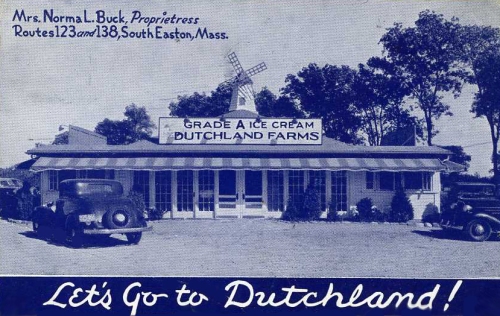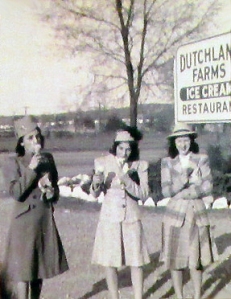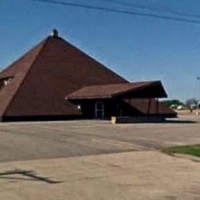 The Dutchland Farms story parallels that of Howard Johnson’s, its competitor and eventual conqueror. Both were chains of ice cream and lunch shops that began on Massachusetts roadways in the 1920s. But they experienced the Depression very differently. Howard Johnson’s expanded while Dutchland Farms shrank. Though Howard Johnson triumphed over its competitor, there is no doubt that Dutchland Farms strongly influenced HoJo’s development.
The Dutchland Farms story parallels that of Howard Johnson’s, its competitor and eventual conqueror. Both were chains of ice cream and lunch shops that began on Massachusetts roadways in the 1920s. But they experienced the Depression very differently. Howard Johnson’s expanded while Dutchland Farms shrank. Though Howard Johnson triumphed over its competitor, there is no doubt that Dutchland Farms strongly influenced HoJo’s development.
Unlike Howard Johnson’s, the Dutchland Farms chain grew out of a real dairy farm, established in 1897 by shoe manufacturer Fred F. Field. Years before the first Dutchland Farm dairy store – not yet a restaurant – opened in 1928, the dairy farm of the same name in Brockton MA had become nationally famous for its prize-winning herd of Holsteins. The ice cream produced by the farm in “28 flavors,” sometimes 30, was advertised as the only Grade A ice cream made in Massachusetts. (Most ice cream then was made from Grade B milk which has a higher bacterial count; now Grade B milk is mostly used for making cheese.)
By 1933 the newly incorporated company had 50 roadside stores that sold milk, butter, and eggs, and also served toasted sandwiches, frankfurters, and fountain treats, as well as “Chinese Chop Suey” supplied by Hung’s Food Products Co. of Boston. Soon the menu expanded to include complete dinners. Menus displayed Dutchland Farms “registered” colors, orange, blue, and white, which also formed the color scheme for buildings. The canvas awnings on the white building depicted on the South Easton MA postcard below would have been in eye-catching orange and blue stripes.
 Fifty was probably the greatest number of Dutchland Farms units in operation at any given time. In addition to eastern Massachusetts where most units were located, the company did business in New Hampshire, Rhode Island, Connecticut, and New Jersey. Some restaurants were operated by the company itself but most were franchised, as was true of Howard Johnson’s. Women formed 10 to 15% of Dutchland Farms proprietors, a large percentage for a restaurant chain.
Fifty was probably the greatest number of Dutchland Farms units in operation at any given time. In addition to eastern Massachusetts where most units were located, the company did business in New Hampshire, Rhode Island, Connecticut, and New Jersey. Some restaurants were operated by the company itself but most were franchised, as was true of Howard Johnson’s. Women formed 10 to 15% of Dutchland Farms proprietors, a large percentage for a restaurant chain.
In addition to colorful awnings, Dutchland Farms buildings had two outstanding visual characteristics: orange roofs and decorative windmills which sat atop the roof or formed part of the building front. The roadside restaurants were situated on busy thoroughfares and both features were intended to attract motorists’ attention. Additional evidence of positioning for mobile customers were Dutchland Farms’ ample parking lots.
 The Depression was rough on Dutchland Farm operators. A dozen or more of the restaurants went out of business. Some proprietors shifted their allegiance to Howard Johnson. A Fairfield CT operator who opened a Dutchland Farms in 1935 switched to Howard Johnson’s after only a few months. Another, Louise Prout, co-proprietor of a Dutchland Farms in Lakeland NH and another in Pocasset MA, decided to go with Howard Johnson’s when she opened a restaurant in Cambridge in 1936.
The Depression was rough on Dutchland Farm operators. A dozen or more of the restaurants went out of business. Some proprietors shifted their allegiance to Howard Johnson. A Fairfield CT operator who opened a Dutchland Farms in 1935 switched to Howard Johnson’s after only a few months. Another, Louise Prout, co-proprietor of a Dutchland Farms in Lakeland NH and another in Pocasset MA, decided to go with Howard Johnson’s when she opened a restaurant in Cambridge in 1936.
Still other Dutchland Farms restaurants became independents. A proprietor near Newport RI rechristened his The Mile Post, while a Dedham MA Dutchland adopted the name of its proprietor, Mary Hartigan. The same fate would one day befall Howard Johnson’s. Louise Prout turned her Cambridge HoJos into The Clipper Ship, disguising the cupola, sheathing the front with dark paneling, and decorating the entry with wrought iron.
Dutchland Farms tried to reorganize its debts in 1939 but was sold to Howard Johnson’s in 1940. Johnson kept the orange, blue, and white colors but was barred from using the Dutchland Farms windmills on restaurants operating as Howard Johnson’s, and chose cupolas instead. However, some of the restaurants he acquired continued to do business as Dutchland Farms and, presumably, kept their windmills. The last Dutchland Farms restaurant I could find evidence of was in Quincy MA in 1951.
It is not obvious why Howard Johnson succeeded and Dutchland Farms failed. Was it because after Repeal Howard Johnson restaurants served alcoholic beverages whereas Dutchland Farms did not? Or was it due to how well the businesses were conducted? Or just luck?
© Jan Whitaker, 2012

 During the war (1941-1945) the creation of 17 million new jobs finally pulls the economy out of the Depression. Millions of married women enter the labor force. The demand for restaurant meals escalates, increasing from a pre-war level of 20 million meals served per day to over 60 million. The combination of increased restaurant patronage with labor shortages, government-ordered price freezes, and rationing of basic foods puts restaurants in a squeeze. With gasoline rationing, many roadside cafes and hamburger stands close.
During the war (1941-1945) the creation of 17 million new jobs finally pulls the economy out of the Depression. Millions of married women enter the labor force. The demand for restaurant meals escalates, increasing from a pre-war level of 20 million meals served per day to over 60 million. The combination of increased restaurant patronage with labor shortages, government-ordered price freezes, and rationing of basic foods puts restaurants in a squeeze. With gasoline rationing, many roadside cafes and hamburger stands close. 1941 When the restaurant in the French pavilion at the New York World’s Fair closes, its head Henri Soulé decides he will not return to a Paris occupied by Germans. He and ten waiters remain in New York and open Le Pavillon. Columnist Lucius Beebe declares its cuisine “absolutely faultless,” with prices “of positively Cartier proportions.” – Chicago cafeteria operator
1941 When the restaurant in the French pavilion at the New York World’s Fair closes, its head Henri Soulé decides he will not return to a Paris occupied by Germans. He and ten waiters remain in New York and open Le Pavillon. Columnist Lucius Beebe declares its cuisine “absolutely faultless,” with prices “of positively Cartier proportions.” – Chicago cafeteria operator  1946 Like health departments all across the country, NYC begins a crack down on
1946 Like health departments all across the country, NYC begins a crack down on  1949 Howard Johnson’s, the country’s largest restaurant chain, reports a record volume of business for the year. HoJos, which has not yet spread farther west than Fort Wayne IN, plans a move into California.
1949 Howard Johnson’s, the country’s largest restaurant chain, reports a record volume of business for the year. HoJos, which has not yet spread farther west than Fort Wayne IN, plans a move into California.










 It's great to hear from readers and I take time to answer queries. I can't always find what you are looking for, but I do appreciate getting thank yous no matter what the outcome.
It's great to hear from readers and I take time to answer queries. I can't always find what you are looking for, but I do appreciate getting thank yous no matter what the outcome.


